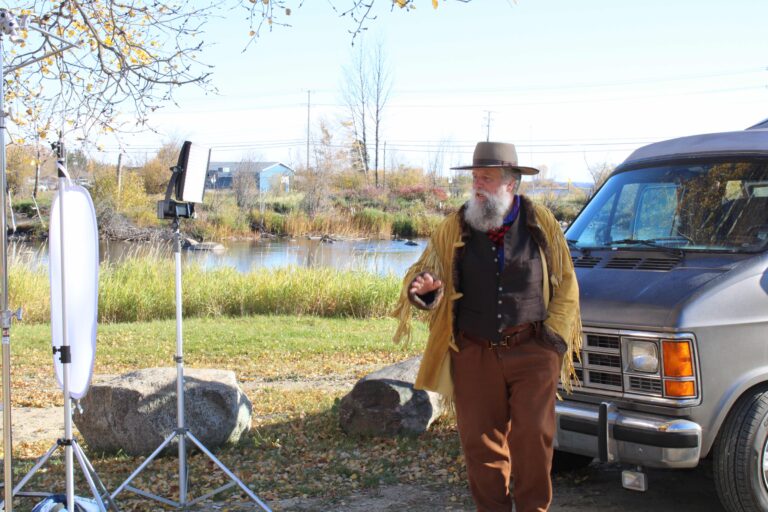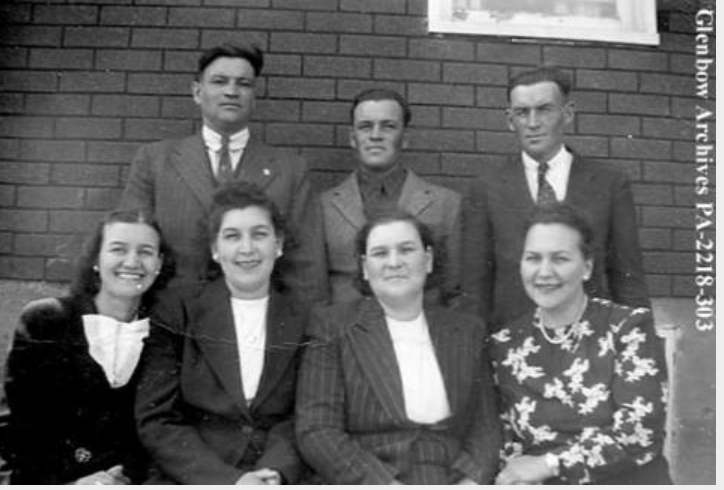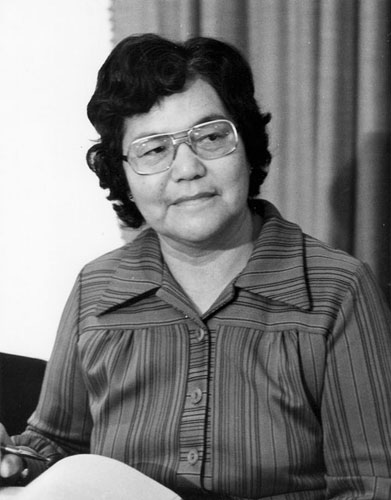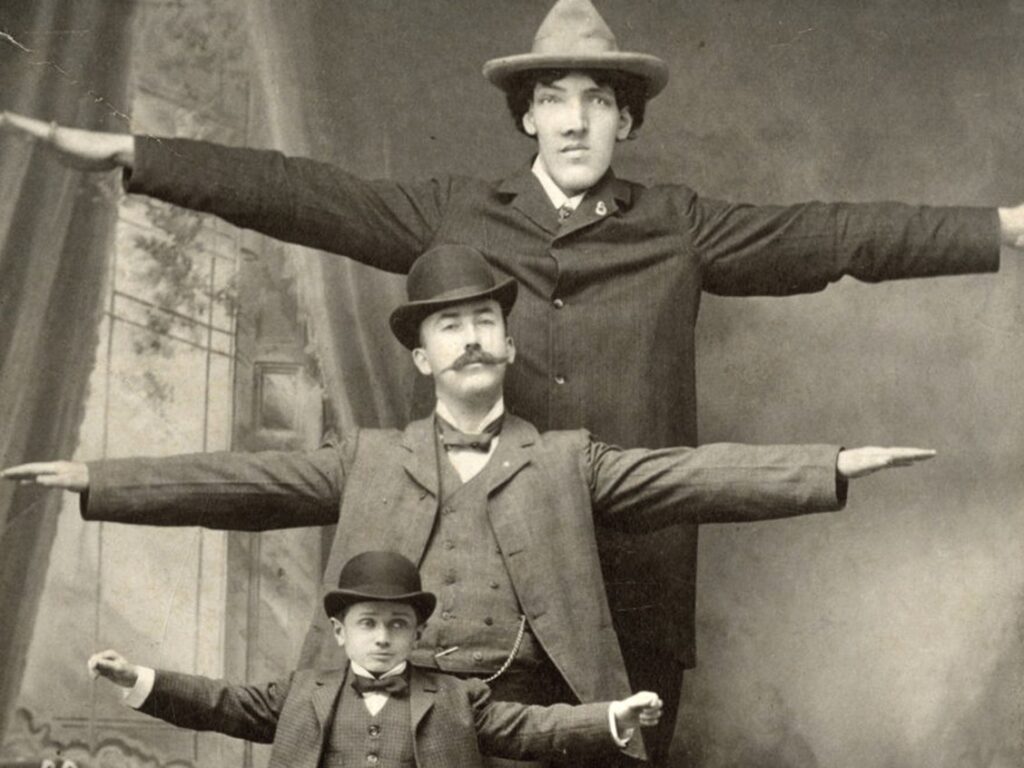
Métis filmmaker Trevor Cameron was in La Ronge last Wednesday filming a new documentary series that features local Métis legend Jim Brady, after whom the Jim Brady Métis Local in La Ronge takes its name.
“I like the call of adventure and I really like seeing places that have hidden histories that may not be hidden to a local but would be hidden to me. If I had to pick one place in Saskatchewan it would be La Ronge,” Cameron said.
“Finding these little snippets of history means that I get to check them out and join with other Métis and have a good time.”
Cameron took inspiration for the series from his last film, Shadow of Dumont, in which the director pilots his campervan across North America to unravel the life of Métis freedom fighter Gabriel Dumont.
Cameron wears the same buckskin jacket and, since Red River carts are hard to come by, travels Saskatchewan in his beloved Dodge camper van named “Le Petit”
“It’s always history but it always has a light touch,” Cameron said.
“There’s humour and clowning because that’s just what I do.”
Métis organizer’s La Ronge connection

Brady is one of the most influential figures in Métis history. He disappeared mysteriously in northern Saskatchewan while on a prospecting trip with Lac La Ronge Indian Band Councillor Absolum Halkett in the summer of 1967.
Their remains were never found, leading to speculation that the friends were murdered, or assassinated for their political activities.
A member of the Communist Party of Canada, Brady was a self-educated Marxist, Socialist, and Métis nationalist active in the radical politics of the 1930s. Cameron credits Brady with the concept of Métis associations that thrive to this day.
“A lot of people in La Ronge are really interested in his disappearance but for me it was about his life and legacy coming to La Ronge. This lifetime of socially organizing the Métis and bringing us the entire idea of Métis organizations,” Cameron said.
“The idea that the Métis can organize is something that keeps getting taken for granted.”
Born in 1908 in St. Vincent, Alberta, Brady moved to La Ronge for work. He lost the job, but never left. Brady was known as a prospector and organizer in the community until going missing at the age of 59.
“He was trying to say let’s get out of these boxes and let’s be cohesive then we can talk about wants and needs as a group,” Cameron said of Brady’s legacy.
“We may not always be the same but we’ll always be together.”
Heroism in a different vein

Cameron will also dive into the stories of Mary Greyeyes from the Muskeg Lake Cree Nation, who was the first First Nations woman to enlist in the Canadian Army, Métis giant Édouard Beaupré of Willow Bunch, and Cowessess First Nation women’s rights icon Mary Ann Lavallée.
“We went all the way back to Willow Bunch and Édouard Beaupré. I only knew of him as ‘the French giant’ when I was younger but the more I did research the more I realized he got Métis scrip, he was speaking Michif, he was Métis,” Cameron said.
“I wanted to know more about his story. This man who grew over eight-feet-tall and went on this adventure much like Gabriel Dumont went on the Wild West Show. There’s an interesting story about that.”
Cameron became interested in Mary Greyeyes when he saw an old war propaganda poster featuring her — but that didn’t name or credit her.
“It was a complete wash of the Indian princess being blessed by the Indian chief to go to war. It was a complete fabrication that was put out. What I got interested in was that she was the first Indigenous woman in the women’s army corps that went to World War II,” Cameron said.
“She survived residential school, she went to war and she spent time in London. She became travelled and she kind of reminded me of my mom. Heroism in a different vein.”
Mary Ann Lavallée of Cowessess also survived residential school and became a nurse. She petitioned the federal government to allow First Nations to use land title as collateral with the bank for loans to improve their farms.
“It was a 10-year battle and that alone made her heroic to me. Then she was helping bring pre-school to the reserves and she was constantly fighting for women’s rights,” Cameron said.
“Here’s a woman who did all this and was in the agricultural hall of fame but I didn’t hear about her. I found her by accident.”
The parts that make you proud

Cameron’s mission is to bring those under-told Indigenous histories to the screen in a heartfelt, positive and genuine way.
“In my mind they were Indigenous people that I felt weren’t brought out and celebrated enough,” Cameron said.
“You’re allowed to look at your own history and the history of others and you’re allowed to enjoy it. Not everything has to be bad news and terrible revelations. Have some fun and don’t beat up history. See if you can find those parts that make you proud.”
Cameron said featuring both Métis and First Nations in the same series was intentional, and in keeping with Brady’s legacy.
“I just don’t care about the labels. To me, all of those little boxes just serve to keep us separate. You’re holding your identity so tight that you’re letting it slip away through being worried about losing it,” Cameron said.
“It feels like the last generation was all about protecting what we held sacred or what we held special and now it’s a time of sharing.”
The series will air in four half-hour segments on Citytv and then as a feature.
